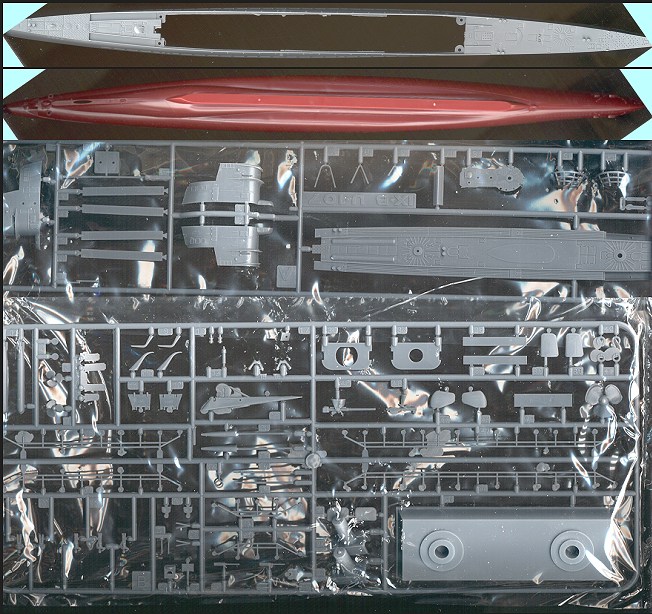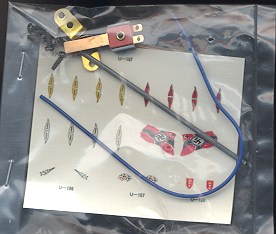
| KIT: | Nichimo 1/200 type IXb U-boat |
| KIT # | U-2009 |
| PRICE: | $21.98 MSRP |
| DECALS: | See review |
| REVIEW & | |
| NOTES: |
|

| HISTORY |
I know darn little about U-boats except what I see on TV andread in books. I do know, from visiting the U-505 in Chicago, that they weresmall and cramped. The idea of spending any time in one gives me claustrophobia.It is difficult to believe that men actually spent months at sea in these littletubes. Having been in WWII US subs, they seem like roomy, luxurious hotels bycomparison.
However, the U-boat was able to nearly bring Englandto her knees by sinking a huge number of ships in the 1940-42 time frame. Unlikethe Japanese, who never used their huge I-boats as commerce raiders, the Germanboats were specifically designed as such and were initially very successful.However, the submarine service had the highest casualty rate of any of theservices with about 30,000 of the 40,000 who went to sea perishing in action.
Duringthe war, there were basically two classes of ocean-going submarine in theKriegsmarine. The Type VII of about 500 tons and the larger Type IX of about 750tons. By the time the Type IX entered service, the art of building submarineswas such that from keel laying until first patrol was about 11 months. The typeIXB portrayed by this kit consisted of the U-64-65, 103-111, and 122-124. Themost produced version was the IXC.
| THE KIT |

The Nichimo kit is probably the finest injected plastic versionof this boat ever done. The parts have some flash on them and appear to bedevoid of ejector pin marks in any unwanted places. The detailing on the partsis very good indeed. I am not sure of when the kit was produced as this is aJapanese-language kit with no English in the instructions. It is also afull-hull version and is capable of being motorized. It looks like it couldeasily float if one sealed the prop shaft.
It is molded in darkgrey plastic with the exception of the lower hull which is molded in red. Whilenot designed as a waterline kit, it seems from looking at it that if one did notinstall the lower hull that it would be darn close to the right height. One isgiven the wiring and switches for motorizing the kit, but not the battery orelectric motor which is obviously an extra. You even get five tiny crewmen tostand watch on the bridge!
A moving feature is the main deck gun,which is designed to move in azimuth should you wish. The center section of themain deck is held in by screws so that one can gain access to the hull to swapout batteries. This means that if one has no intention of motorizing their boat,that there will be a slot in the hull where the prop shaft comes out as well asthe four screw holes to fill in.
 There are access panels amidships fore and aftof the conning tower that are removable and there are two torpedoes that can beplaced under these panels. The painting colors are called out during the varioussteps, but again, being in Japanese, I cannot make them out. This is where agood reference comes in handy!
There are access panels amidships fore and aftof the conning tower that are removable and there are two torpedoes that can beplaced under these panels. The painting colors are called out during the varioussteps, but again, being in Japanese, I cannot make them out. This is where agood reference comes in handy!
The instruction sheet is of theusual diagrams so no construction problems are expected, though it would be niceto be able to read the notes. There is a small decal sheet that includesmarkings for three boats: U-106, U-107 and U-108 from the second constructionbatch. This sheet also includes a flag and several pennants denoting tonnagesunk.
Overall, it looks like a relatively simple kit to build andshould pose no problems to anyone but the bare beginner.
| REFERENCES |
Kriegsmarine by Robert C Stern,1979, Squadron/SignalPublications
Axis Submarines by Anthony J Watts, 1977, Arco Publishing
Review copy courtesy of me and my wallet!
If you would like your product reviewed fairly and quickly by asite that has over 900 visits a day, please contactme or see other details in the